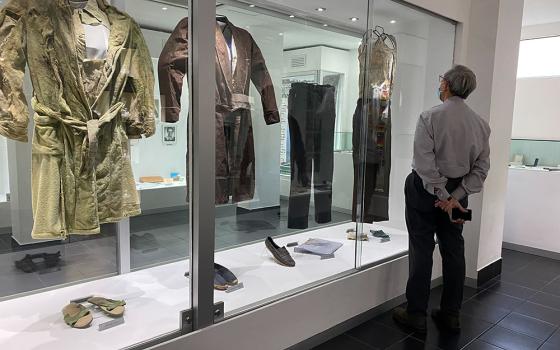In the past year, NCR has published several articles written jointly by Fr. Drew Christiansen, S.J. and Ra’fat Aldajani all of which treat the subject of relations between the Israelis and the Palestinians. The articles share a bias so extreme as to warrant the harsh designation that they are tendentious at best and inflammatory at worst.
Here is a survey from some of those articles that prove the point.
In an article entitled “Palestinian poetry reflects a painful longing for home,” the authors quote a poem by Mahmoud Darwish:
I am Adam of the two Edens, I who lost paradise twice.
So expel me slowly,
and kill me slowly,
under my olive tree
Christiansen and Aldajani follow this quote with the remarkable observation: “The remembrance of paradise is dissolved in a bitterness in which death is preferable to exile.” I say remarkable because the authors seem not to notice that their literary observation points to a real source of the on-going conflict, the willingness of Palestinians to prefer death to peace. Peace for the Palestinians will necessarily mean letting go of dreams about returning to certain areas now under Israeli control. That is what happens when control over an area is disputed.
An earlier article was entitled “Relentless land grabs in the occupied West Bank.” I am opposed to Israeli settlements in most of the West Bank, to be sure, and see how they make any peaceful resolution of the conflict more difficult and more distant. As Christiansen and Aldajani note, there are many Israelis who oppose more settlements as well. But, in their article, the authors make this observation: “The minister's death was a reminder that the battle for rural land in the occupied West Bank is at the heart of the conflict.” Really? Yassir Arafat walked away from a peace plan that would have given him and his people almost all the rural land in the West Bank. In 2008, the Palestinians walked away from a proposal that would have given them 93% of the West Bank. And, of course, the unilateral withdrawal of Israel from Gaza, including the forced removal of Jewish settlers, did not result in peace, did it?
There is a deeper problem with that sentence about the “heart of the conflict,” a problem that, I think, is part of what accounts for Christiansen’s and Aldajani’s extreme bias. They write as if the only political reality in the region was the Palestinian-Israeli conflict. They see a well-armed and potent Israel fighting poorly armed Palestinians and it seems like a David and Goliath story, with all the sentimentality that analogy suggests. But, if they were to widen their lens, and see the region as an Israeli Defense Minister must, that is, without sentimentality, they would see a cauldron of political pathologies in the Arab world, all of which threaten Israel. The Arab Spring, that great stab at democratic norms, is dead, and it was not killed by Israelis. The rise of Islamicist extremism has brought chaos and turmoil to Lebanon and Syria on Israel’s northern border, and the Muslim Brotherhood in Egypt, though less extreme than Hezbollah or Isis or, importantly, Hamas, was nonetheless a not very reliable partner in peace for Israel. And, the most important border for Israel is that with Jordan and that country has never been politically stable except by comparison. If Israel had returned to its 1967 borders at any point in the past ten years, does anyone really think there would be peace for Israel? Christiansen and Aldajani know the answer: The one article they wrote on Islamic extremism did not mention Israel.
Another device used by Christiansen and Aldajani to paint the Israelis as the villains is the inappropriate analogy. They began an article entitled “Home demolition as vengeance” with probably their worst such overwrought comparison:
On Dec. 14, 2012, 20-year old Adam Lanza walked into Sandy Hook Elementary School in Newtown, Conn., and shot and killed 26 people, 20 children and 6 adults. Shortly after the massacre, Newtown authorities demolished the home of Peter Lanza, Adam’s father, leaving him and his other son homeless. Police explained the action as ‘a deterrent’ for future school shooters.
Apart from the school shooting by Adam Lanza, the story above is not all true. In the United States, authorities don’t demolish family homes of suspected mass-killers as a deterrent.
The difference between the two situations is obvious to everyone except, apparently, Christiansen and Aldajani. As far as I can recall, there was no one celebrating Adam Lanza’s attack on the Sandy Hook School, certainly not the authorities of the town of Newtown, nor those of the State of Connecticut, nor federal officials. In America, we condemn those who commit such atrocities. In the West Bank, they lionize those who do so. I do not think the Israeli tactic of destroying the homes of those who commit terrorist attacks is effective and would, if it were up to me, scrap it. But, I hope to God that the Israelis will find an effective tactic, and I wish to God that the Palestinians would condemn terrorism instead of celebrating it. That hope and that wish do not justify the outrageous analogy employed by Christiansen and Aldajani. And, if any reader has any doubts about the degree to which Palestinian political culture warms to the prospect of terror, recall the celebrations in the West Bank on September 11, 2001. Yes, celebrations. Here is the video:
Tomorrow, I will conclude my examination of Fr. Christiansen's and Mr. Aldajani's essays.



